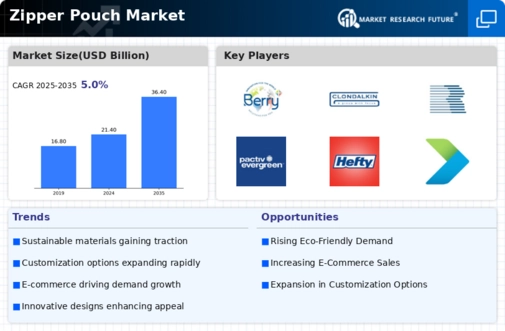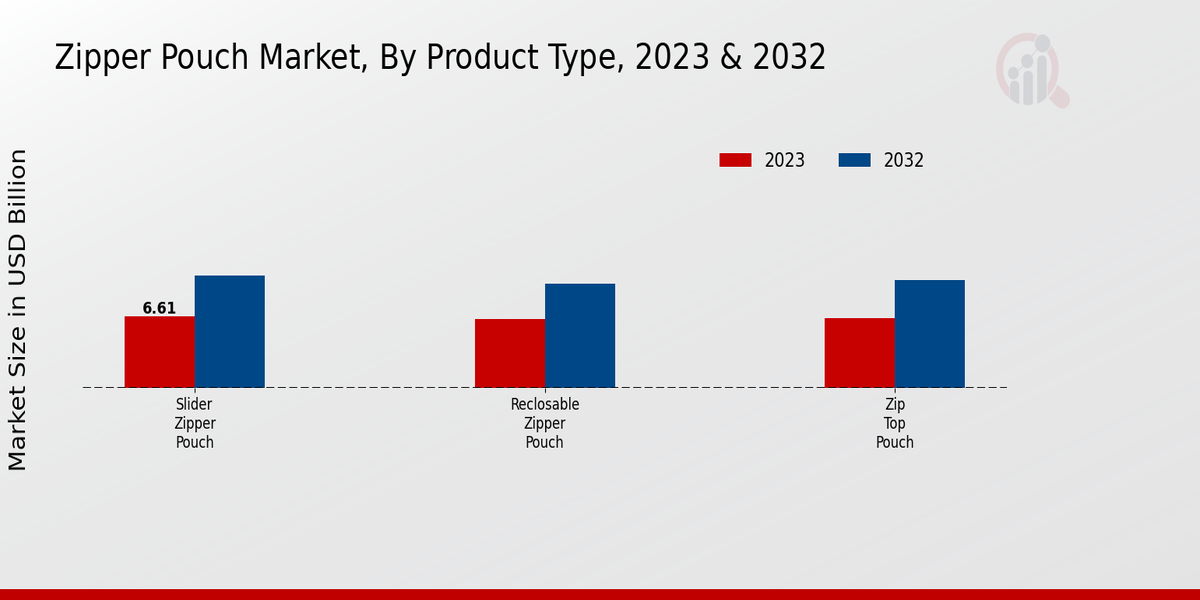Market Growth Projections
The Global Zipper Pouch Market Industry is poised for substantial growth, with projections indicating a market value of 21.4 USD Billion in 2024 and an anticipated increase to 36.4 USD Billion by 2035. This growth trajectory suggests a robust demand for zipper pouches driven by various factors, including sustainability, technological advancements, and diverse applications. The expected CAGR of 4.96% from 2025 to 2035 further emphasizes the market's potential for expansion. As industries continue to seek innovative packaging solutions, the zipper pouch market is likely to evolve, adapting to changing consumer preferences and technological advancements.
Increasing Use in Food Packaging
The food packaging segment significantly drives the Global Zipper Pouch Market Industry, as zipper pouches provide an effective solution for preserving food freshness and extending shelf life. Their resealable feature appeals to consumers seeking convenience and practicality in food storage. As the global population continues to grow, the demand for efficient food packaging solutions is expected to rise. This trend is reflected in the market's anticipated growth, reaching 21.4 USD Billion in 2024. The versatility of zipper pouches in accommodating various food products further solidifies their position in the packaging industry.
Diverse Applications Across Industries
The versatility of zipper pouches across multiple industries is a significant driver of the Global Zipper Pouch Market Industry. These pouches are utilized in sectors such as cosmetics, pharmaceuticals, and electronics, owing to their ability to provide protection and convenience. For example, in the cosmetics industry, zipper pouches are favored for their aesthetic appeal and functionality, allowing brands to enhance product visibility. This broad applicability contributes to the market's resilience and growth potential, with projections indicating a rise to 36.4 USD Billion by 2035. The adaptability of zipper pouches ensures their continued relevance in various market segments.
Growth in E-Commerce and Retail Sectors
The expansion of the e-commerce and retail sectors significantly influences the Global Zipper Pouch Market Industry. With the rise of online shopping, packaging solutions that ensure product safety and enhance presentation are in high demand. Zipper pouches, known for their convenience and versatility, are increasingly utilized for packaging various products, from food items to cosmetics. This trend is expected to contribute to the market's growth, with projections indicating a rise to 36.4 USD Billion by 2035. The convenience of zipper pouches aligns well with the fast-paced lifestyle of consumers, further driving their adoption in retail.
Technological Advancements in Packaging
Technological innovations play a crucial role in the evolution of the Global Zipper Pouch Market Industry. Advances in manufacturing processes, such as improved sealing techniques and material enhancements, have led to the production of more durable and functional zipper pouches. These innovations not only enhance the user experience but also reduce production costs, making zipper pouches more accessible to a broader range of industries. As a result, the market is poised for growth, with a projected CAGR of 4.96% from 2025 to 2035, indicating a robust future driven by continuous technological improvements.
Rising Demand for Eco-Friendly Packaging
The Global Zipper Pouch Market Industry is experiencing a notable shift towards sustainable packaging solutions. As consumers become increasingly environmentally conscious, manufacturers are adapting by producing zipper pouches from biodegradable and recyclable materials. This trend aligns with global initiatives aimed at reducing plastic waste, thereby enhancing brand reputation and customer loyalty. For instance, companies that incorporate eco-friendly practices often report increased sales and customer engagement. The market's projected growth to 21.4 USD Billion in 2024 underscores the importance of sustainability in driving consumer preferences and purchasing decisions.















